Scanning the Original and Sending to a Computer
By changing the paper document to PDF or XPS, you can send the file to shared folder on the computer.
Benefits from Changing the Paper Document to PDF or XPS
You can save space.
You can improve search performance of the text on the document.
Reduction in printing costs and conservation of paper resources
You can set a password for security. (PDF only)
|
Required Condition
|
|
You can connect to the computer with the shared folder from this machine via the network.
|
This section describes how to create a "PDF-Scan" shared folder on a drive of a Windows computer that is connected to the machine via the SMB protocol and send a scanned two-sided document to that folder as a PDF file.
The screens may differ, depending on the model of the machine and on attached optional products.
The screens may differ, depending on the operating system of your computer.
Follow the procedures below.
Creating a Shared Folder
Registering an Address
Sending from the Machine
1.
Check for the computer name.
For Windows Vista/Windows 7, click [

] (Start) → right-click [Computer] → click [Properties] → check for the computer name.
For Windows 8/8.1, place the cursor on the top right (bottom right) of the desktop → right-click [Computer] → click [Properties] → check for the computer name.
For Windows 7
2.
Right-click a blank area on the desktop → click [New] → [Folder] to create a new folder → enter 'PDF-Scan' as the folder name.
3.
Select [Share this folder].
For Windows Vista/Windows 7/Windows 8/Windows 8.1, right-click the "PDF-Scan" folder → select [Properties] to display the [PDF-Scan Properties] dialog box → click the [Sharing] tab → click [Advanced Sharing] → select [Share this folder] → click [Permissions].
For Windows 7
4.
Select [Everyone] → check that [Allow] for <Change> is selected → click [OK]. If [Allow] is not selected, select [Allow] → click [OK].
For Windows 7
5.
For Windows Vista/7/8/8.1, in the [PDF-Scan Properties] dialog box, click the [Security] tab → click [Edit] → [Add].
6.
Enter 'Everyone' → click [OK].
7.
For Windows Vista/7/8/8.1, select [Everyone] → select [Allow] for <Modify> → click [OK] → [Close].
For Windows 7
A shared folder to send data is created.
|
NOTE
|
For Windows Vista/7, the shared folder is displayed as  . |
You can specify the settings to use the shared folder ([Public] folder).
1.
Click [Sharing] on the [System Preferences] screen.
2.
Select [File Sharing].
The [Public] folder is now shared on the network.
You can share files in [Drop Box] in [Public]. You can access the [Drop Box] as follows: On the [Go] menu, click [Home] → [User] → select the login user name → [Public] → [Drop Box].
|
NOTE
|
|
The appearance of the screen may differ from the one you actually see, depending on the version of the operating system you are using.
|
You can perform this procedure using the touch panel display or the Remote UI. Using the Remote UI, you can register a destination with ease.
1.
Start your Web browser → enter the IP address of the machine in [Address].
http://<IP address of the machine>
The portal page of the Remote UI is displayed.
|
NOTE
|
If you want to confirm the IP address of the machine, press  (Settings/Registration) on the control panel and follow the procedure below. Press  (Settings/Registration) → [Preferences] → [Network] → [TCP/IP Settings] → [IPv4 Settings] → [IP Address Settings]. If you cannot access the above settings, specify the proxy exclusion settings following the procedures below.
|
(1)
|
Click [Tools] on the Internet Explorer menu bar → [Internet Options] → [Connections] tab → [LAN Settings].
|
|
(2)
|
Select [Use a proxy server for your LAN (These settings will not apply to dial-up or VPN connections).] → click [Advanced].
|
|
(3)
|
Enter the IP address of the machine in [Do not use proxy server for addresses beginning with:] → click [OK].
|
If the following error messages are displayed and you cannot access the Remote UI, follow the procedures below.
Page Not Found:
Select [Tools] from the menu bar → [Internet Options] → display the [General] sheet → delete the temporary internet files. Then, restart the Web browser and access the Remote UI again.
HTTP 404 File Not Found:
Check the IP address. Check the IP address range settings in the Network settings of the machine.
|
2.
Click [Address Book] → [Address List 01] on the Address List screen.
3.
Click [Register New Destination]. A screen for registering a new destination is displayed.
4.
From the Type drop-down list, select [File] → click [Set].
5.
Specify the desired settings on the [Register New Destination: File] screen → click [OK].
|
Name:
|
Enter a name for the destination. You can specify a desired name.
|
|
Protocol:
|
Select [Windows SMB].
|
|
Host Name:
|
\\Computer Name\PDF-Scan (For the computer name, if you are using Windows, enter the computer name that you checked in step 1 of "For Windows" in "Creating a Shared Folder," If you are using a Macintosh, enter the computer name that you checked in step 2 of "For Mac OS" in "Creating a Shared Folder.") |
|
The following items can be set by clicking [Settings]:
|
|
Folder Path:
|
If you want to create a folder named "Temporary" in the PDF-Scan folder, enter '\Temporary'. You can send without entering this field.
|
|
User Name:
|
Enter the sender's user name (the name used to log in to the computer).
|
|
Confirm Before Sending
|
Select to display the confirmation screen before sending.
|
|
Password:
|
Enter the password that corresponds with the user name.
|
|
Confirm:
|
Reenter the same password for confirmation.
|
The destination you entered is registered.
Using the Touch Panel Display
1.
Press [Scan and Send] on the Main Menu screen.
|
NOTE
|
|
If the Main Menu screen is not displayed, press [Main Menu].
|
2.
Select [Address Book].
3.
Press [Regist./Other] → [Register/Edit].
4.
Press [Register New Dest.] → [File].
5.
Press [Name] → enter a new name for the file → press [Next].
|
[Name]:
|
Enter a name for the destination. You can specify a desired name.
|
6.
Specify each setting.
|
<Protocol>:
|
Select [Windows SMB].
|
|
[Host Name]:
|
Enter the computer name that you checked in step 1 of "For Windows" in "Creating a Shared Folder," or step 2 of "For Mac OS" in "Creating a Shared Folder." You can also press [Search Host] to search for the destination computer. |
|
[Folder Path]:
|
Specify the folder of the destination computer to save to. You can also press [Browse] to specify the folder of the destination computer.
|
|
[User Name]:
|
Enter the sender's user name (the name used to log in to the computer).
|
|
[Password]:
|
Enter the password that corresponds with the user name.
|
7.
Press [Check Connection] to check the connection to the file server.
8.
Press [OK].
You can create an OCR (Text Searchable) PDF file from a two-sided original.
1.
Place your originals in the feeder → press [Scan and Send] on the Main Menu screen.
|
NOTE
|
|
If the Main Menu screen is not displayed, press [Main Menu].
|
2.
Press [Address Book].
3.
Select a registered destination → press [OK].
4.
Press the file format button.
5.
Select [PDF] → press [Set Details].
6.
Press [OCR (Text Searchable)] → [OK] → [OK].
7.
Press [Options].
8.
Press [2-Sided Original] → specify the type of two-sided original → press [OK].
9.
Press

(Start).
The document is changed to searchable PDF, and is sent and stored in the shared folder.
You can convert original color/grayscale images scanned at a resolution of 300 dpi to compact (approx. 1/10 original size) PDF or XPS files. This mode eliminates the issue of the large file size of digitized documents, reducing color documents to the size of black-and-white documents. This also enables you to reduce the load on the network and servers. For details, see
"Compact PDF or XPS."Searchable PDF or OOXML
This mode enables you to perform OCR (optical character recognition) to extract data that can be recognized as text from the scanned image, and add it as a transparent layer of text to create a PDF or OOXML file that is searchable. If the file is a searchable PDF file, you can quickly search for the necessary information on the PDF or OOXML. For details, see
"Searchable PDF/OOXML."Trace & Smooth PDF (Universal Send Trace & Smooth PDF Kit Is Required)
This mode enables you to divide and extract the text, line drawings, and background of a scanned image, and convert the text and line drawings to scalable outline data to be placed on the background when creating a PDF file. For details, see
"Trace & Smooth Settings."Enhanced text quality
Outlining the text edges eliminates "jagginess" even when the text is enlarged, enhancing the overall quality of the text in the PDF.
Practical application of data
The outlined data on the PDF can be extracted and used in Adobe Illustrator.
|
NOTE
|
|
The Trace & Smooth PDF mode can be used with the Searchable PDF, Encrypted PDF, Digital Signatures, and PDF Files with a Security Policy modes.
Trace & Smooth PDF is linked with Compact PDF. Thus, if you select the Trace & Smooth PDF mode, Compact PDF is automatically set and the PDF file size is reduced.
If you select Trace & Smooth for the PDF file format, the resolution must be set to 300 dpi, and [Full Color] or [Grayscale] must be set for the color mode.
|
You can set a password for a PDF file. If a PDF file is encrypted with a password, you cannot open, print, or change the PDF file without entering the correct password. If you want to restrict access, it is recommended that you set a password before sending. For details, see
"Encrypting PDF Files."Changing the Default Settings
By storing the specified send settings as the default settings, you can recall the settings without specifying the settings again. For details, see
"Changing the Default Settings for Scan and Send."If You Cannot Use SMB to Communicate with Windows
If you cannot use SMB to communicate with Windows, follow the procedures below.
Firewall:
For Windows Vista
Right-click [Network] → click [Properties] → [Windows Firewall] → [Turn Windows Firewall on or off] → [Change settings] → select [Off] → [OK].
-For Windows 7
Right-click [Network] → click [Properties] → [Windows Firewall] → [Turn Windows Firewall on or off] → select [Off] for [Home or work (private) network location settings] and [Public network location settings] → click [OK].
For Windows 8/8.1
Place the cursor on the top right (bottom right) of the desktop → select [Settings] → [Control Panel] → [Windows Firewall] → [Turn Windows Firewall on or off] → select [Turn off Windows Firewall (not recommended)] for [Private Network settings] and [Public Network settings] → [OK].
Shared Simple File Settings:
For Windows Vista
Right-click [Network] → click [Properties] → click the arrow on the right of [File Sharing] for [Sharing and Discovery] → select [Turn on file sharing] → [Apply].
For Windows 7
Right-click [Network] → click [Properties] → [Change advanced sharing
settings] → select [Turn on network discovery] → [Turn on file and printer sharing] → [Save Changes].
For Windows 8/8.1
Place the cursor on the top right (bottom right) of the desktop → select [Network] → [Properties] → [Change advanced sharing settings] → select [Turn on network discovery] → [Turn on file and printer sharing] → [Save Changes].
Properties of the Shared Folder:
Right-click the shared folder → select [Properties] → click the [General] tab → deselect [Read-only] → [Apply].
Access Privilege of the Shared Folder ([Sharing] Sheet):
For Windows Vista/7/8/8.1
Right-click the shared folder → select [Properties] → click the [Sharing] tab → click [Advanced Sharing] → select [Permissions] → [Apply].
Security Policy:
Click [Start] → [Control Panel] → [Administrative Tools] → [Local Security Policy] → [Local Policies] → [Security Options] → [Microsoft network server: Digitally sign communications (always)] → [Disabled] → [Apply] → restart Windows.
Login Password:
If you are using Windows, you can login to the computer using a local account without a password set. However, the following issues may arise:
If <Check the login destination, user name, and password> is displayed, you cannot set the login/destination from the machine.
You can set the login/destination from the machine, but you cannot use the Push Scan function.
The above issues related to accounts with no specified password arise because authentication was not performed at the time the folder on the network was accessed.
From a security perspective, and to avoid the above issues, login using an account with a password.
Logging in an Active Directory Environment:
When a computer that one or more users log on to is restricted by the administrator in an Active Directory environment, follow the procedure below to register the name of the computer.
Open the user account properties dialog box. Click [Logon To] to open the [Logon Workstations] dialog box → set the computer name in the user account properties dialog box to "CANON + the last 8 digits of the MAC address of the computer + 00". For example, if the MAC address of the computer you are using is "00:00:11:22:33:44", set "CANON1122334400".

 ] (Start) → right-click [Computer] → click [Properties] → check for the computer name.
] (Start) → right-click [Computer] → click [Properties] → check for the computer name.
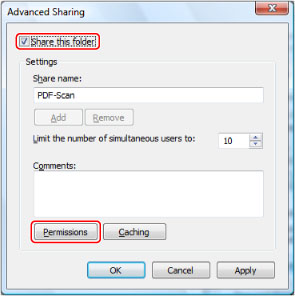


 .
.
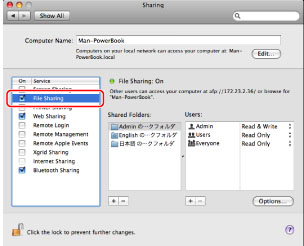

 (Settings/Registration) on the control panel and follow the procedure below.
(Settings/Registration) on the control panel and follow the procedure below.  (Settings/Registration) → [Preferences] → [Network] → [TCP/IP Settings] → [IPv4 Settings] → [IP Address Settings].
(Settings/Registration) → [Preferences] → [Network] → [TCP/IP Settings] → [IPv4 Settings] → [IP Address Settings].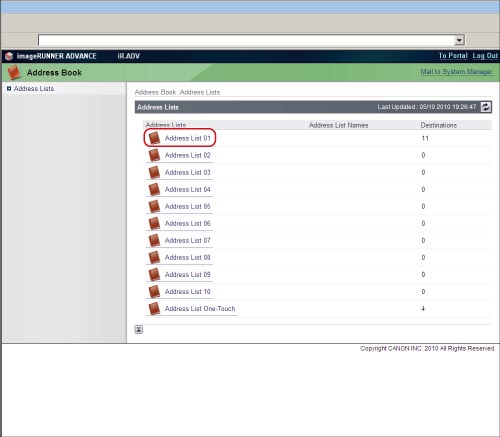



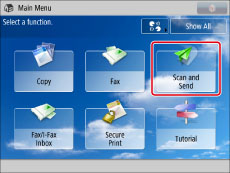







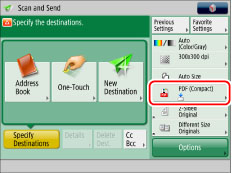



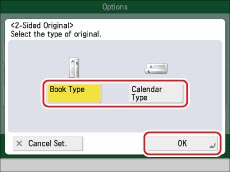
 (Start).
(Start).